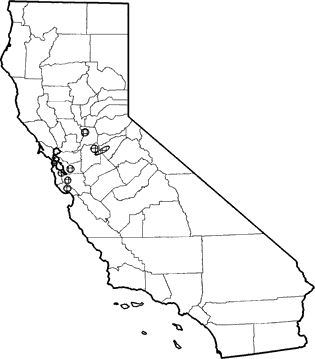
Eastern Gray Squirrel
Distribution, Abundance, and Seasonality
The eastern gray squirrel has been introduced from eastern U.S. to cities, campuses, and large private estates in the vicinity of San Francisco Bay and in Sacramento, San Joaquin, Calaveras, and Stanislaus cos. Populations of eastern gray squirrels are found in orchard-vineyard, urban, and possibly valley foothill riparian habitats.

Range Map
Specific Habitat Requirements
Feeding: Eastern gray squirrels eat a variety of fruits, flowers, nuts, berries, and occasionally insects. Fruits and nuts eaten include maple, beech, elm, walnut, oak, buckeye, and various species of Prunus and Malus (Barkalow and Shorten 1973, Smith and Follmer 1972, Thompson and Thompson 1980). Selects food with highest energy (Smith and Follmer 1972). Caches mast in scatterhoards in the fall for winter and spring use. Food intake is lowest in winter.
Cover: Seeks cover in trees, preferably dense stands which allow travel between trees in the canopy (Gilroy 1980, Flyger and Gates 1982).
Reproduction: Uses tree cavity; also builds a nest of twigs and bark. May move the young to a new nest if the original site is disturbed (Barkalow and Shorten 1973).
Water: About half of daily water needs are met through food. Will take snow as a source of water (Barkalow and Shorten 1973).
Pattern: Prefers dense stands of large trees and snags with abundant cavities, mast, preferably near water.
Species Life History
Activity Patterns: Yearlong diurnal activity. A peak in activity occurs in September and October, when caching food (Flyger and Gates 1982).
Seasonal Movements / Migration: Generally none, but some mass movements are reported in the eastern U.S. (Flyger and Gates 1982).
Home Range: Has a smaller home range than fox squirrel, generally ranging from 0.5-1.8 ha (1.25-4.5 ac) (Flyger and Gates 1982), but one urban population had male home ranges of 20.2 ha (50.5 ac) and female home ranges of 2.0-6.1 ha (5.0-15.2 ac). Size of home range varies with available food, habitat quality, and sex.
Territory: Generally has overlapping home ranges, but may become territorial at high densities. A dominance hierarchy controls mating, access to food sources, and access to nest sites (Flyger and Gates,1982).
Reproduction: May breed in any month in California. Mating occurs from December through March, and again in June elsewhere. Gestation requires about 44 days. The young are born from January through April, and in July. The 2 litters per yr average about 3 young each. Food availability may limit the size and number of litters. The altricial young nurse for 6 wk, but are not fully independent until 12 wk of age (Barkalow and Shorten 1973). Matures at 11 mo. Yearlings generally produce only 1 litter.
Niche: May be sympatric with western gray squirrels in urban and valley foothill riparian habitats (Gilroy 1980), and with fox squirrels in some urban locales. In Kansas, sympatric fox and eastern gray squirrels had overlapping home ranges, and there were heterospecific feeding aggregations (Armitage and Harris 1982). Eastern gray squirrels tend to occur in denser woods than fox squirrels in most areas where they both occur (Gilroy 1980, Flyger and Gates 1982). Hawks and owls are the principal predators. Snakes prey on young.
Sources & References
California Department of Fish and Game, 1999.
California's Wildlife, Sacramento, CA.
Written by: G. Hoefler, J. Harris, reviewed by: H. Shellhammer, edited by: R. Duke, S. Granholm
Armitage, K. B., and K. S. Harris. 1982. Spatial patterning in sympatric populations of fox squirrels (Sciurus niger) and gray squirrels (S. carolinensis). Am. Midl. Nat. 108:389-397. Barkalow, F. S., Jr., and M. Shorten. 1973. The world of the gray squirrel. J. B. Lippincott Co., Philadelphia and New York. 103pp. Byrne, S. 1979. The distribution and ecology of the non-native tree squirrels Sciurus carolinensis and Sciurus niger in northern California. Ph.D. Thesis, Univ. Calif., Berkeley. 190pp. Flyger, V., and J. E. Gates. 1982. Fox and gray squirrels. Pages 209-229 in J. A. Chapman and G. A. Feldhamer, eds. Wild mammals of North America. Johns Hopkins Univ. Press, Baltimore, MD 1147pp. Gilroy, A. M. 1980. Habitat analysis of Sciurus niger and Sciurus carolinensis in the Santa Cruz Mountains of California. M.A. Thesis, San Jose Univ., San Jose. 33pp. Ingles, L. G. 1965. Mammals of the Pacific states. Stanford Univ. Press, Stanford, CA. 506pp. Robinson, D. J., and I. McT. Cowan. 1954. An introduced population of the gray squirrel (Sciurus carolinensis Gmelin) in British Columbia. Can. J. Zool. 32:261-282. Smith, C. C., and D. Follmer. 1972. Food preferences of squirrels. Ecology 53:82-91. Thompson, D. C. 1978a. Regulation of a northern gray squirrel (Sciurus carolinensis) population. Ecology 59:708-715. Thompson, D. C. 1978b. The social system of the gray squirrel. Behavior 64:305-328. Thompson, D. C., and P. S. Thompson. 1980. Food habits and caching behavior of urban gray squirrels (Sciurus carolinensis). Can. J. Zool. 58:701-710.
California Animal Facts | California's Wildlife